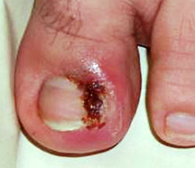The exact causes and conservative treatment options of ingrown toenails are one of the most common presentations in a family medical practice. Medically termed as 'onychocryptosis', it is a condition which usually occurs in the second and third decades of life, however younger individuals can develop this condition if the corners of their toenails are torn.
Common causes of ingrown toenails include: poor nail trimming techniques in which the nails are cut too deep from the corners, trauma, neoplasm beneath the nail, obesity, and severe pressure on the toenail. These changes can result in inflammation and edema in the lateral nail fold.
Practitioners have classified the presentation of ingrown nails in three stages. In the first stage there is redness, puffiness, and pain when pressure is applied to the lateral nail fold. In the second stage comparatively worse signs appear like purulent discharge and thus infection. In the third and final stage granulation tissue appears in this nail and the nail hypertrophies.
The treatment of every stage varies. The first stage can be managed conservatively with a warm antiseptic soak, elevation of the nail corner with cotton wick, and the use of antibiotics. In the second stage, a portion of the nail is removed, but this is not always successful. In only thirty percent of the cases is this condition eradicated by this method. Third stage requires the removal of the lateral nail plate with a lateral matritectomy. In this case of toenail removal, granulation tissue is also removed from the nail.

